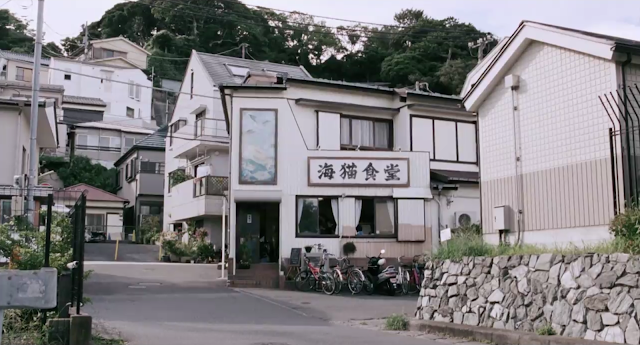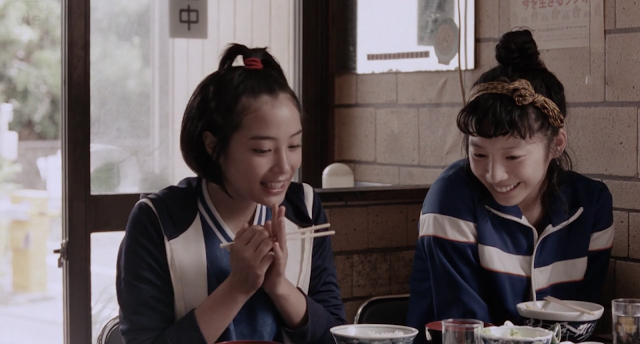The scene
Suzu is adapting well to her new life. She’s started school, joined the school football team and found new friends. One day after practice the football team goes for a meal at Umineko Shokudou, a local restaurant owned by a family friend of the sisters.
Well, it looks like some kind of smallish deep-fried fish. What kind of fish? It's never mentioned here, so we have no idea... unless you use your time-travelling powers and take a look at a later scene in the film. The sisters visit the diner later in the movie and Sachi orders fried mackerel, aji furai, which happens to look exactly like what Suzu has in front of her here. Mackerel seems to be Ninomiya's specialty since there is also another mackerel dish of hers that makes an appearance later in the show.
It looks like there are some kind of vegetables that go alongside with the fish but it's a bit difficult to make out what they might be. At least cabbage, I'd say, which would match the aji furai recipes I've seen online.
We also see some more Japanese table manners in this scene. Suzu is really excited to dig in but remembers to stop, put her hands together and say "itadakimasu". This is what you do and say before eating (also when drinking something), much like saying "bon appétit", although "itadakimasu" literally translates as "I will humbly accept it". And after eating, instead of thanking for the food directly with an "arigatou gozaimasu", you say "gochisousama deshita", literally meaning "it was a feast". Both phrases have deep roots in Japanese history and Buddhism, which you can read about for example here. They are very important and useful phrases to know if you ever visit Japan!
Umineko Shokudou. As far as I understand, the name’s very literal translation is ”Sea Cat Diner”, but the ”sea cat” actually seems to refer to a kind of seagull, so maybe it's "Seagull Diner". It’s apparently a real place in Kamakura!
The soccer team, having fun doing impressions of famous football players. On the left we see the coach and sitting next to him is Suzu's new friend Fuuta. Chika and Hamada were watching the practice session and have tagged along as well.
Chika tells Suzu about her new team. She says Fuuta is the opposite of the sisters since he only has two brothers, and the coach is a colleague of Sachi's at the hospital they work at.
We then meet the owner, the sweet and friendly Ninomiya, who brings Suzu her meal. The sisters have been eating at Ninomiya's diner ever since they were children.
The man at the counter is Ninomiya's good friend Fukuda who runs a small café in Kamakura.
The food
Alright, let's take a look at the food.Well, it looks like some kind of smallish deep-fried fish. What kind of fish? It's never mentioned here, so we have no idea... unless you use your time-travelling powers and take a look at a later scene in the film. The sisters visit the diner later in the movie and Sachi orders fried mackerel, aji furai, which happens to look exactly like what Suzu has in front of her here. Mackerel seems to be Ninomiya's specialty since there is also another mackerel dish of hers that makes an appearance later in the show.
It looks like there are some kind of vegetables that go alongside with the fish but it's a bit difficult to make out what they might be. At least cabbage, I'd say, which would match the aji furai recipes I've seen online.
We also see some more Japanese table manners in this scene. Suzu is really excited to dig in but remembers to stop, put her hands together and say "itadakimasu". This is what you do and say before eating (also when drinking something), much like saying "bon appétit", although "itadakimasu" literally translates as "I will humbly accept it". And after eating, instead of thanking for the food directly with an "arigatou gozaimasu", you say "gochisousama deshita", literally meaning "it was a feast". Both phrases have deep roots in Japanese history and Buddhism, which you can read about for example here. They are very important and useful phrases to know if you ever visit Japan!
Recreating the food
So, it was time for some deep-frying action again, which I was now familiar and pretty comfortable with after already having made tempura and tonkatsu. But what about the fish itself? I think I've seen fresh mackerel perhaps twice in Finland, and I've never the kind of small ones that you can fry whole like in the scene. The word "aji" in the name of the dish indicates that this is Japanese horse mackerel, a very common fish in the waters surrounding Japan. Could I find something similar in Finland?
Well yes, kind of, in the Asian markets in Helsinki. Those stock a variety of frozen fish, including some more exotic kinds which you would never find in a regular Finnish supermarket. At Thai Orchid Market I spotted these intriguing little fellows:
The label in the store said they were Indian mackerels which don't seem to be the same Japanese horse mackerels, but they were indeed mackerels and around the same size as the Japanese ones, a little under 20 cm in length. However, they were steamed, which I was hoping wouldn't affect the end product too much... but unfortunately it totally did. The flesh turned out to be very crumbly and thus unusable for aji furai - just like I feared. Back to square one.
I decided to go with whatever fresh Finnish fish would be most suitable for the dish. There were a few potential candidates at my local supermarket's fish counter. I was initially thinking of using Baltic herring for this recipe but the fillets were quite small, plus they had no tail fins, which I really wanted so that the dish would at least look the part even if it didn't taste exactly like the real thing. The whole herrings were of a horse mackerel-like size, but I'm still a complete newcomer when it comes to gutting fish and didn't really want to try to learn to do it right now. There were other fillets of fish too which might've been closer to mackerel in taste but those also lacked the tail fin. In the end I went with vendace.
So, now I was mostly pleased with my fish selection and was ready to fry 'em. I found this simple aji furai recipe on The Japan Times and got to work.
Well yes, kind of, in the Asian markets in Helsinki. Those stock a variety of frozen fish, including some more exotic kinds which you would never find in a regular Finnish supermarket. At Thai Orchid Market I spotted these intriguing little fellows:
The label in the store said they were Indian mackerels which don't seem to be the same Japanese horse mackerels, but they were indeed mackerels and around the same size as the Japanese ones, a little under 20 cm in length. However, they were steamed, which I was hoping wouldn't affect the end product too much... but unfortunately it totally did. The flesh turned out to be very crumbly and thus unusable for aji furai - just like I feared. Back to square one.
I decided to go with whatever fresh Finnish fish would be most suitable for the dish. There were a few potential candidates at my local supermarket's fish counter. I was initially thinking of using Baltic herring for this recipe but the fillets were quite small, plus they had no tail fins, which I really wanted so that the dish would at least look the part even if it didn't taste exactly like the real thing. The whole herrings were of a horse mackerel-like size, but I'm still a complete newcomer when it comes to gutting fish and didn't really want to try to learn to do it right now. There were other fillets of fish too which might've been closer to mackerel in taste but those also lacked the tail fin. In the end I went with vendace.
Vendace is a very popular fish in Finland and one of my personal favourites. It's somewhat mild in taste but also a bit fatty and has white flesh, which sort of matches how horse mackerel is described, so I thought it should be as close a match as you could get here. It's generally a small enough fish that you can eat it whole, spine, fins and head and all, although the larger ones might need gutting. These ones were about 15 cm in length without the head, around the same size as the aji furai Suzu has in front of her. They were gutted but still had the spine intact, which I removed in order to get the "butterfly" kind of fillet. Easy enough. Maybe I'll have to look into the whole gutting thing later.
Mix water, some flour and an egg to make the batter. I also still had plenty of panko bread crumbs left over from the tonkatsu.
Coat the fillet in the batter, roll in the bread crumbs, pop in the oil.
I again used the spatula trick to check the temperature of the oil. It didn't take long at all for the batter to become a lovely golden brown, after which I flipped the fillets and fried them for a few minutes more.
As for the veggies I simply followed the recipe above - get some of your favourite salad ingredients, cut into a chopstick-friendly size.
When I made this dish I was just about to go away from home for a week or two, so I decided not to go too crazy when making the sauce. I went with the same sauce I made for the tonkatsu - ketchup, worcester sauce, mirin, soy sauce and mustard powder.
The scene shows the table full of various bowls and plates but it's impossible to make out what they are having, apart from the obligatory steamed rice. In the end this time I decided to just have the aji furai as shown in the recipe.
Here's my recreation of Ninomiya's aji furai!
Trying it out
I was extremely pleased with how the fish turned out. Although Ninomiya's fish seems to have a nicer, more even coating, I think it looks the part, tail fin and all. How was the taste? Well - basically criminally good, but also exactly as I expected. I've been eating and loving fried vendace since I was a kid, and this was very similar to the stuff I'd had before. The batter is slightly different, as it the way the fish is prepared and presented (usually the Finnish version uses the tiniest possible vendace). However, what you don't usually have with the fish here is the sauce and salad. Those turned out to be the thing that took the dish to the next level. The cool and fresh salad were the perfect counterpart to the crispy hot fish, and the tonkatsu sauce gave it an extra bit of flavour.
I still want to try actual mackerel (perhaps the next time I'm in Japan), but otherwise this was an easy-to-prepare and very tasty dish and I consider it a fantastic success!
Recipes used
Aji no furai: The Japan Times













Comments
Post a Comment